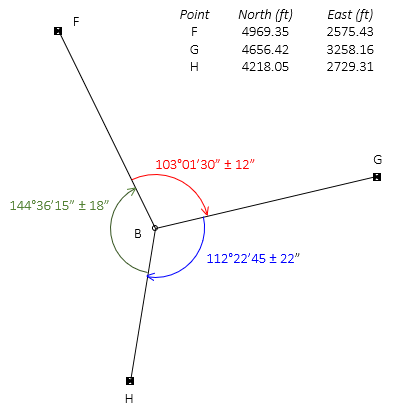2. Triangulation
A triangulation network is a survey composed of primarily angle measurements. Before electronic distance measurement, most control surveys were done with triangulation since it was faster to measure angles than distances. Triangulation networks required periodic distances, called baselines, to help fix geometry. But a point position can be fixed with just angle measurements for an intersection like in Figure H-3.
 |
| Figure H-3 Intersection by Angles |
The survey has three measurements and two unknowns so a least squares adjustment can be used to determine point B's coordinates.
Point B initial coordinates
There isn't sufficient information to easily compute coordinates for point B (try it, you'll see). But because the adjustment is iterative, we just need reasonable coordinate values to start with. The better the initial values, the fewer iterations needed.
We'll guesstimate coordinates based on point B's proximity to the others. Point B is approximately one third the distance north from point H to point F and approximately one quarter the distance east from point F to point G:

Matrix Structures
Because each angle has an uncertainty, a weight matrix will be used.

Set up observations
General angle observation equation: F-From, A-At, T-To

Since point B is the At point for all three angles, only the third and fourth terms of the observation equation are computed.
Compute distances

Angle FBG



Angle GBH



Angle HBF



Set up matrices

[K] matrix values are large due to point B's guesstimated coordinates. If they are too far off, the solution might not converge. Let's see what happens.
Solve the matrix algorithm iteratively
![]()
First iteration

Coordinate corrections are relatively large, a reflection of our guesstimated point B coordinates.
Updated coordinates are: NB1 = 4,556.558 EB1 = 2,779.278
Second iteration
Recomputed matrices

Corrections are getting smaller - going in the right direction. All right!
Updated coordinates are: NB2 = 4,545.909 EB2 = 2,783.113
Third iteration

Now we're cooking - corrections are smaller. One more should do it.
Updated coordinates are: NB3 = 4,545.954 EB3 = 2,782.940
Fourth iteration

Bingo! The solution took four iterations because our initial coordinates for point B were pretty rough. A better guesstimate might have reduced the iterations to three or possibly two. Worse approximations might have increased the iterations or possibly caused the solution to diverge.
Final coordinates: NB = 4,545.954 EB = 2,782.940
Adjusted Angles
Because the final corrections are 0.000, the angle residuals are the last computed [K] matrix values.

Position uncertainties


Compute standard and 95% CI error ellipses







The standard and 95% CI error ellipses are shown in Figure H-4.
 |
| Figure H-4 Standard and 95% CI Error Ellipses |
Because the ellipses are much smaller than those in the trilateration example, they must be magnified considerably more (500x) in order to be seen.
Adjustment Summary
| NB = 4,545.954' ±0.018' | EB = 2,782.940' ±0.014' | |
| Error Ellipse | ||
| AzU = 158°22' | ||
| SU = ±0.018' | SV = ±0.014' | |
| SU 95% = ±0.254' | SV 95% = ±0.198' | |